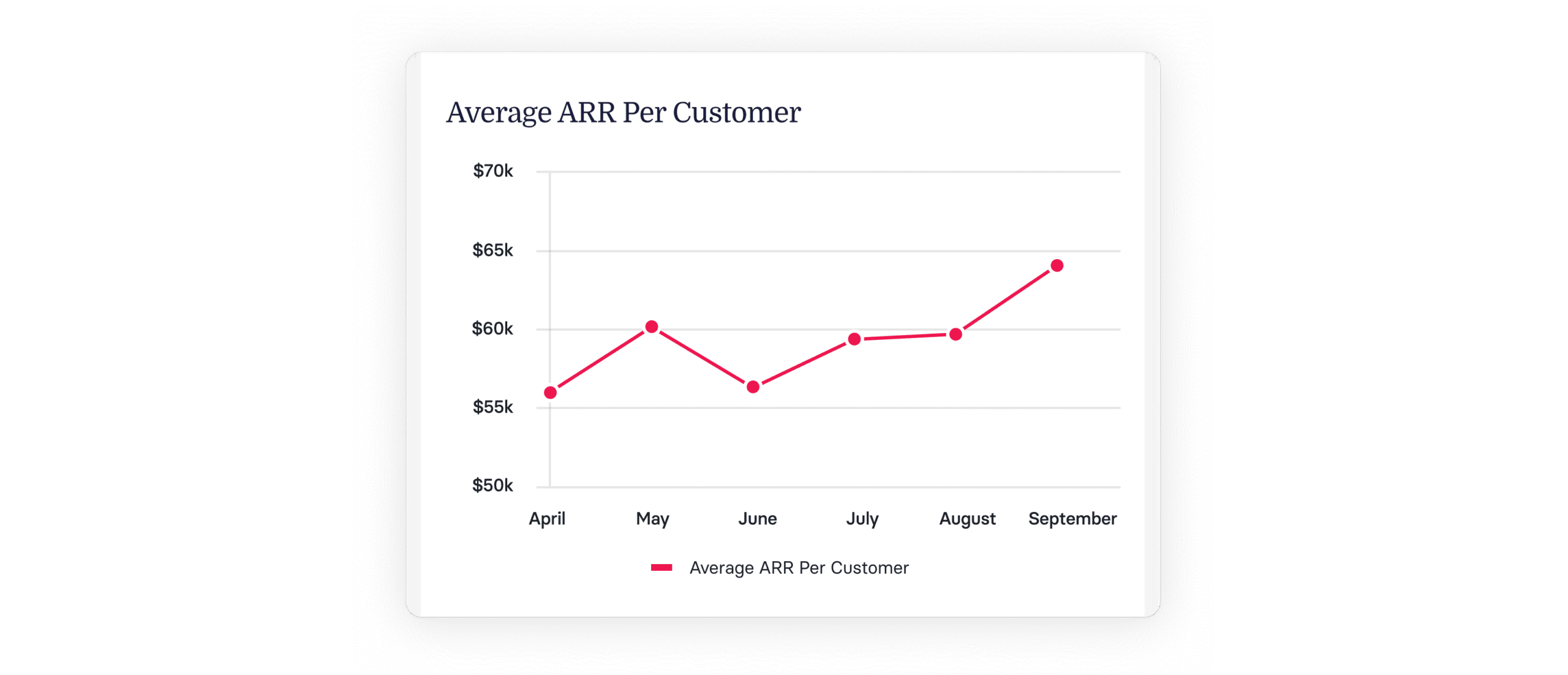Average revenue per account (ARPA) measures revenue from customer accounts and aids in evaluating financial performance and customer relationships.
What is average revenue?
Average revenue shows how much revenue your company generates per unit or per customer account. While it’s a non-GAAP metric, it’s a valuable tool for executives and investors to assess how effectively the business generates revenue—and to evaluate growth potential at a more granular, unit-level view.
<<Download the SaaS metrics cheat sheet.>>

Average revenue is an important financial metric for SaaS companies. It helps you:
- Estimate the number of subscriptions needed to hit profitability goals
- Pinpoint areas that may be impacting margins
- Plan strategies for sustainable growth
That said, there are a few different ways to calculate average revenue—each with its own nuance. Let’s break them down, starting with the basics.
Average revenue formula + how to calculate
The average revenue formula divides total revenue by the number of units you sell:

Average revenue example
Let’s say your company’s total revenue is $20,000, and you’ve sold 2,000 subscription plans for your SaaS product. In that case, your average revenue is:
- AR = TR/Q
- AR = $20,000 / 2,000 = $10
- So, each subscription’s average revenue is $10 per unit
What is the average revenue per account (ARPA)?
Average revenue per account (ARPA) is a key metric for SaaS businesses, showing how much revenue each customer account brings in—typically measured monthly or annually.
Subscription-based companies rely on ARPA to evaluate:
- Important financial ratios, such as customer lifetime value (LTV)
- Sales pipeline metrics, such as customer acquisition cost and payback period
- Performance
- Customer segmentation
- Revenue forecasting
- Spend forecasting
How to calculate ARPA
To calculate ARPA, divide your total revenue in a specific period by the total number of accounts in that same period:

If you want to calculate monthly ARPA, divide the total monthly recurring revenue (MRR) by the total number of accounts in that month:

Let’s say a SaaS company has 2,000 active accounts and brings in $200,000 in monthly revenue. The monthly ARPA would be:
- Monthly ARPA = $200,000 / 2,000 = $100 per account per month
Another helpful metric to track alongside ARPA is average sales price (ASP), which shows the average revenue generated from new accounts. Breaking ASP down by region or salesperson can offer deeper insight into which markets or team members are contributing most to top-line growth.
<<Get a head start on your top-line planning with this ARR snowball template.>>
What is the average revenue per user?
Average revenue per user (ARPU) measures how much revenue your business generates per individual user over a specific time period. Comparing ARPU to ARPA can help you assess how effectively your revenue scales as your customers add more users to your product.
Recommended For Further Reading
How to calculate average revenue per user
To calculate ARPU, divide the total revenue in a specific period by the total number of users in that same period:

If you want to calculate monthly ARPU, divide the total monthly recurring revenue (MRR) by the total number of users in that month:

Outside the SaaS space, ARPU is commonly used by telecom companies to track average revenue per mobile phone subscriber each month. It includes monthly billing as well as revenue from incoming calls paid through regulatory interconnection systems.
In SaaS, ARPU is most relevant for businesses with a seat-based pricing model. You might charge a flat fee for platform access, with an additional cost per user—or offer unlimited seats under a fixed subscription. In either case, ARPU helps you understand how user-level revenue aligns with account-level growth.
For example, if a website hosting company with 1,000 customers brings in $50,000 in monthly revenue, ARPU would be:
- ARPU = $50,000 / 1,000 = $50 per user per month
If you offer a freemium model, it may be more insightful to calculate ARPU based only on paying customers, rather than the entire user base.
What is average revenue per unit?
Average revenue per user (ARPU) and average revenue per unit are often used interchangeably—but they’re not quite the same.
Average revenue per unit looks at the revenue generated from selling a single unit of a product. It’s more commonly used by businesses that sell physical goods, such as ecommerce brands, rather than software or services.
How to calculate average revenue per unit
You’ll calculate average revenue per unit the same way you calculate the average revenue per user: Divide the total revenue by the total units sold in a given period.

For example, if a game publisher sold 5,000 copies in a month and earned $100,000 in revenue, the average revenue per unit would be:
- Average revenue per unit = $100,000 / 5,000 = $20 per unit
Key takeaways
- Understanding average revenue metrics—ARPU and ARPA—empowers you to assess revenue generation and guide strategic decisions
- Average revenue per account (ARPA) measures revenue from customer accounts and aids in evaluating financial performance and customer relationships
- Average revenue per user (ARPU) helps understand revenue efficiency per user, crucial for businesses with seat-based pricing models
- Choosing the right metric depends on your business model and pricing strategy to effectively track and optimize revenue growth
When to use ARPA vs. ARPU
Whether you focus more on ARPA or ARPU depends on your pricing model.
If your business doesn’t charge by user, ARPU may not be the most meaningful metric. In that case, tracking ARPA offers a clearer picture of how effectively you’re growing revenue—especially through expansion.
On the other hand, if your pricing is seat-based or varies with active users, ARPU becomes more valuable. It helps you measure the return on adding users and how that impacts overall growth and customer value.
Average revenue FAQs
What is the difference between average revenue and marginal revenue?
Average revenue measures how much revenue you earn per account or user over a specific time period. Marginal revenue is a bit more complex—it models how much additional revenue you can expect from selling one more unit, factoring in scale and changes in demand. It’s more of an economic concept that highlights how pricing and demand impact growth.
What is a good ARPU?
There’s no universal benchmark for ARPU—it’s highly dependent on your pricing model and business strategy. A strong ARPU for one company might not be ideal for another, even in the same industry. Instead, look at ARPU trends over time. Is revenue per user increasing or declining? Are cross-sells or upsells helping you generate more from your existing base?
What is a good ARPA?
Like ARPU, ARPA doesn’t have a one-size-fits-all benchmark. Use it as a directional metric to track how your revenue per account is evolving over time.
What is the difference between ARPU and LTV?
ARPU is a snapshot of average revenue per user or unit during a specific period. LTV (lifetime value) adds churn into the mix to estimate how much revenue an account will generate over its entire relationship with your company.

